Learn How to Grow Sugar Apple in easy steps and enjoy this flavor fruit fresh in your garden by learning all the tricks on its growth and care!
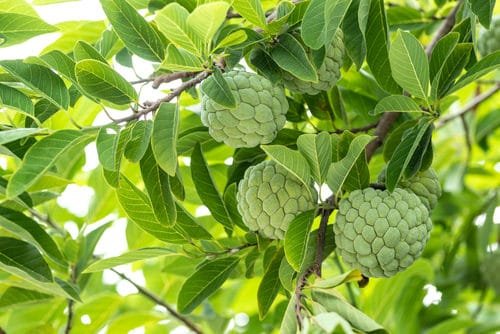
The sugar apple (Annona squamosa) belongs to the Annonaceae family. Although previously it was believed that it is a native of India, but it is believed that it is of either Indian or Central American origin. These fruits are great in taste and go really well in puddings and jellies. Let’s have a look at How to Grow Sugar Apple!
USDA Zones— 9 – 11
Difficulty— Moderate
Other Names— anón, anón de azucar, anona blanca, fruta do conde, cachiman, saramuyo, grenadilla, qishta, ishta, shta, seureuba, fruta-do-conde, fruta-pinha, fruta-de-conde, condessa, pinha, ata, anona, aajaa thee, plae teib, Zimtapfel, Gishta, γλυκόμηλο, kachiman, foreign lychee (番鬼荔枝), hvaðerþetta, (शरीफ़ा/सीताफल), sitaphala, seethappazham, sitaphal, sitappalam, sita phalamu, Sita’s fruit, srikaya, sweetsop, sweet-sop, matomoko, conicony, buah nona, hairico, pomme cannelle, aati, saripha, fasadabur, Sharifa (شريفا), atis, Anoda, Katu Atha, sakya, pinyin, sek-khia, sek-kia, matopetope, noi-na (น้อยหน่า), ekistaferi, mãng cầu ta, Khirmish (خرمش).
Check out our article on growing apples here
Sugar Apple Tree Information
It is a low-growing semi-deciduous tree or large shrub that grows between 3-7 m high, with a spreading or open crown, formed by branches growing in an irregular form. Young shoots grow zigzag and are grayish-waxy, odorous when crushed.
The flowers are pendulous, axillary, hermaphrodite (bisexual), and usually solitary but can grow in groups of two to four. Sugar apple flowers are fragrant and have a green tint in the outside and cream on the inside. These flowers are 1 to 1/2 inches long and have six petals.
The fruits are oval-shaped, from 5 to 12 cm in diameter of green-yellowish color. Externally the union of the carpels is lax. The pulp is white or yellowish between binding carpels with many seeds. It is sweet, aromatic, buttery, edible, of pleasant and creamy flavor.
How to Grow Sugar Apple Tree
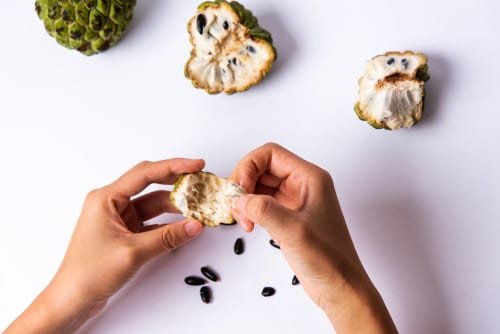
From Seeds
Seed propagation is the traditional method through which the sugar apple tree is grown. It is the most used propagation method. However, this method has several disadvantages such as low germination rate, high genetic variability, late start of the harvest and the plants are taller and rather difficult to handle.
Collect seeds from fully ripe fruit from a tree that has excellent production, great taste, and good health. The seeds quickly lose their viability (approximately 6 months) therefore, they should be planted as soon as possible.
Seed should be planted horizontally, 2 – 3 cm deep at a distance of 1.5 cm in a good quality seed mix. Generally, the germination occurs within 30 days. Although, its germination rate is low and time is slow due to the tough seed coating.
Tip: To speed up the germination and success rate, scarify the seeds with sandpaper. After scarification, soak them in warm water for 24 hours. You can directly sow the seeds on the planting site or plant them in a small pot. The transplanting is done when seedlings have outgrown their existing pot.
Grafted Tree
The other type of propagation is vegetative propagation using grafts. This method is the most recommended because it ensures plants with the same genetic identity, with better production, a healthy tree, and quality fruits. If possible, buy a grafted tree from a nursery.
Planting Sugar Apple Tree
Plants should be planted 4 x 4 or 5 x 5 m apart. The size of the planting hole depends on the size of the plant and its root ball, but generally, the planting hole should be twice wide and of the same depth of the root ball.
How to Grow a Sugar Apple Tree in Pot
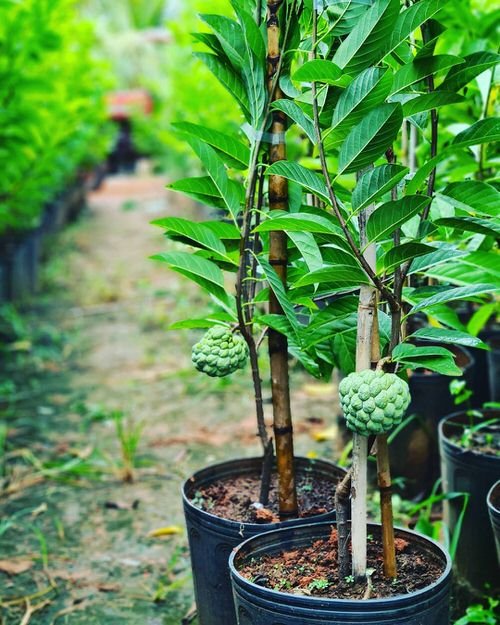
It is possible to grow a sugar apple tree in a pot. It is similar to other tropical fruit trees like guava or pomegranate. Regular pruning will be required. Besides this, all the growing requirements, which are given below are similar to the sugar apple tree planted on the ground.
Best Varieties
The ‘Seedless Cuban’ is one of the most important cultivars. Its fruits are slightly malformed and medium-sized with traces of undeveloped seeds. The flavor is less attractive than normal fruit, but it is more productive.
Indian horticulturists recognized ten types of sugar apple cultivars, which are given below:
- ‘Red’ (A. squamosa var. Sangareddyiz)
- ‘Red-speckled’
- Crimson
- Yellow
- White-stemmed
- Mammoth
- Balangar
- Kakarlapahad
- Washington
- Barbados
- British Guiana
Requirements for Growing Sugar Apple Tree
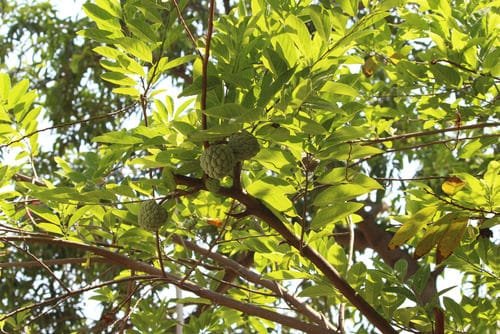
Ideal Climate and Temperature
The most optimum temperature for growing sugar apple trees is around 50 F – 85 F (10 – 30 C). Despite being a tropical tree, the sugar apple has some resistance to the cold. However, when the temperature falls below 32 F (0 C), emerging seedlings and young plants die.
Mature trees show some frost tolerance to some degrees below the freezing point. Furthermore, the temperatures above or below optimum temperature affect pollination, can cause fruit or bud drop, and reduce post-harvest life.
Watering
The plant easily handles extended periods of drought. However, excessive drought can cause leaf and fruit drop. For optimum growth, it requires an annual rainfall between 750 and 1,200 mm. In rainy watering must be stopped. Generally, you should water a mature tree every 12 to 15 days (more on this below).
There must be adequate moisture in the soil to encourage vegetative growth and blooms that occur on the new branches. The tree should be watered every 2 – 4 weeks during the period of low growth and every 3 to 5 days while it is flowering and setting fruits. The water stress must be prevented, and soil must be kept moist at this time as the fruit is more sensitive than the leaves to lack water.
Soil
It is undemanding when it comes to soil type. *Sitaphal cultivation (*common name in the Indian subcontinent) can be done in the poor, stony soil of pH level 7-8. Though it grows in a wide range of soils, from sandy, clay to loam, but the healthiest and the productive tree is grown in fertile, loose, deep, and neutral or slightly alkaline soil that is not sandy with good drainage and aeration.
Furthermore, drainage is essential to prevent diseases. The growth is directly related to the content of organic matter in the soil.
Humidity
Relative humidity is one of the climatic factors that are highly responsible for the formation of flowers and pollination. Therefore, if you want to increase productivity, humidity should be maintained above 60% especially during the flowering period.
Sugar Apple Tree Care
Fertilizer
Application of complete fertilizer in the initial years of planting is recommended. Once the tree matures enough and able to set fruits the use of 3: 10: 10 fertilizer significantly increases the flowering, fruit setting, and harvest.
As for organic fertilization, sugar apple responds well to the application of organic matter from its earliest period of growth. The application of organic fertilizer improves the texture of the soil and its condition and facilitates root development. It is recommended to apply 60 to 80 kg of aged manure or compost annually.
Pollination
Sugar apple has complete flowers (bisexual). However, the male and female flower parts are functional at different times of the day (called *protandry, a condition in which an organism begins life as a male or female and changes the sex later).
Sugar apple flowers first open during the day as a female flower. If the female flower isn’t pollinated, early in the next morning the flowers open wider and shed pollen (male stage). It is recommended to attract pollinating insects or hand pollinate the flowers for the best yield. To find out how to hand pollinate flowers, read this.
This cycle is shortened when temperatures are high and lengthened when they are low.
Pruning Sugar Apple Tree
- Pruning must be done only in the spring if you are in a cold climate. Sugar apple trees tend to form many branches, so pruning is recommended to train the tree into the required shape and to regulate the number of main branches.
- Maintenance pruning serves to preserve the balance of the tree structure by removing suckers or shoots and branches that are growing in the wrong direction or directed towards the ground.
- Likewise, you should do sanitary pruning after each harvest. Sanitary pruning is the removal of branches and fruits that are damaged or have pest or disease problems.
- Renewal pruning is done after around 10 years when the tree grows old and has less vigor and production. In renewal pruning, the tree must be trimmed strongly but in several stages so that it will start its growth once again.
Wind Protection
Like all the other softwood trees, the sugar apple is susceptible to wind damage. Breakage and tearing of branches are possible. Plus, the sugar apple fruits get easily damaged due to the rubbing of branches.
Furthermore, the strong, dry winds accelerate the drying of stigma, thus reduced pollination. Therefore, it should be planted in a location that is sheltered from the wind.
Sugar Apple Pests and Diseases
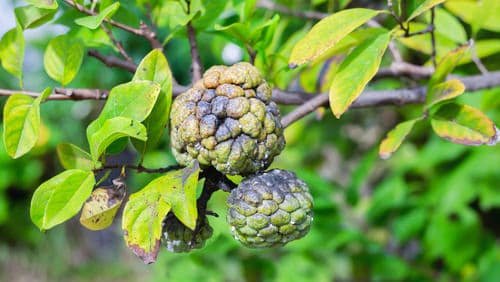
The sugar apple tree is very vulnerable to pests. This reduces its production.
Usually, the pests and insects infest the fruits and cause destruction. The best practice is to protect the fruits using fruit covers. Plastic bags, paper, or polyethylene can be used to wrap the fruits since the initial stage of development. The bags must cover the fruit throughout their development but must be open at the base and have micro-perforations to allow gaseous water leakage because the excess moisture causes fruit rot.
Chemical control measures are difficult, so it is better to prevent the pests by keeping the tree healthy also remember the use of insecticides destroys friendly insects and pollinators. Some of the most common and major pests you need to look for are moths, aphids, mealybugs, and scales.
Among the most common diseases are anthracnose and leaf spot. These diseases occur with severity in times of rain, high and stable temperature, and relative humidity.
Weed management
Growing sugar apple trees requires weed management. It causes the biggest drawbacks during the young stages. The control can be manual, mechanical, or inert, with the use of herbicides or by doing a combination of methods.
You can also do mulching to stop weeds. The best way is to weed regularly and prevent the growth of other plants near the base of the tree.
Harvesting Sugar Apples
- The sugar apple tree begins to produce fruits at the age of 3-4 years and declines after 12-15 years. An average adult tree produces between 100-180 fruits a year.
- The decision of the optimal harvest time is something critical. Also, all fruits do not ripen at the same time and the time of the collection varies, depending on the variety and conditions of weather where they are grown.
- Visual methods based on the discoloration of the skin and shape of the fruit are the most commonly used today to decide when to harvest.
- Another indication of ripening is the change in color of seeds, which pass from light brown color to almost black at the ripened stage.
- These criteria are generally unreliable to indicate proper maturity and fruits are sometimes harvested before ripening. That’s why commercial producers use chemicals to ripen the fruit post-harvest.
- Fruits must be harvested by cutting the stem using pruning shears. Also, it should be harvested in the morning. The sugar apple fruit is very delicate and should be harvested with extra care.
Sugar Apple Uses
- The fruits are consumed mainly fresh, as they have a rich, creamy, sweet flavor. They are very delicious, nutritious, rich in sugar, protein, and phosphorus, with a highly digestible pulp.
- They are also used in desserts and the recipes of juices, sorbets, desserts, wine and ice cream.
- The dried unripe fruits, seeds and leaves powder are used as insecticides. The leaves, stems, and seeds contain fibers, oils, and various alkaloids.


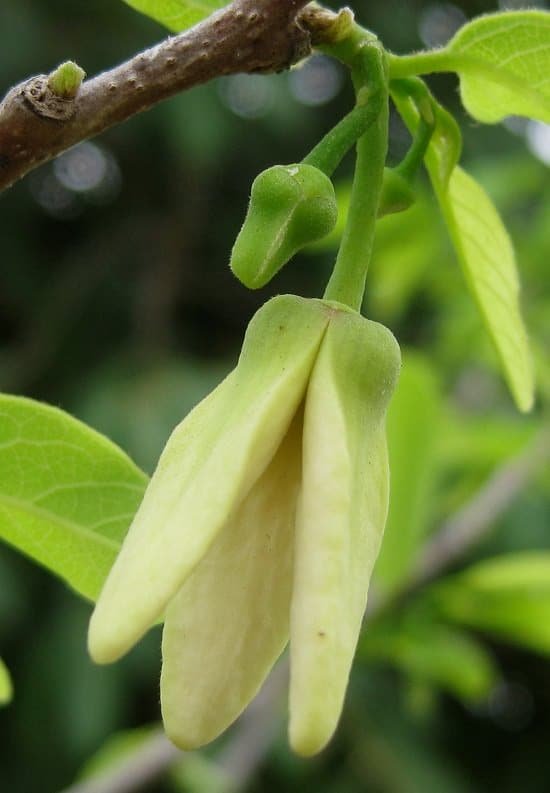
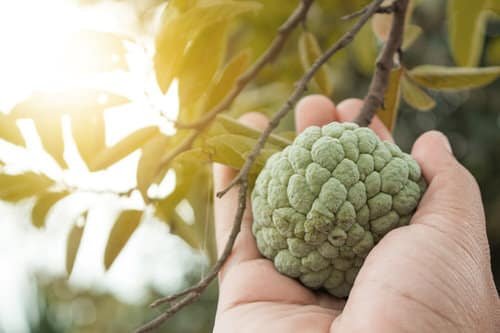

Hi.
My sugar apple plant is about 2 1/2 feet tall. What might the cause of its leaves turning yellow?
Hi Ryree,
There can be several reasons of yellowing leaves. Most probably it can be due to excessive watering or cold. What is the temperature range where the tree is kept? Is it indoor or outside? Are leaves falling after yellowing?
Sugar apple is quite sensitive to excessive watering. Symptoms of excessive watering include yellowing leaves, stunted growth, leaf wilting and browning, leaf drop, stem dieback, and even the death of the tree is possible.
Hi,
My apple sugar suddenly the leaf wilting, what can I do,
The temp at my area is zone 9, the night time I put it in patio.
I changed the soil to make sure it moist. I am afraid off my plant will be die, would you help, thank you.
helen
I have the yellowing problem too. All the leaves are yellow at the edges but the rest of the leaf is green. Gradually the yellowing spreads to the entire leaf and the leaf falls off. This is happening to the leaves closer to the ground first and going upwards, dropping the leaves one by one. Can you suggest a specific reason?
My plan shed off all the leaves. I leave in the dry tropical region of Nigeria I guess the temperature contributed. I started watering daily and within a week its alive and has leaves growing.
Can you recommend any reputable nursery where I can buy a grafted sugar apple tree for container growing? Also, can you recommend a place where I can buy sugar apple seeds?
Thanks very much
I bought two sugar apple at Fast Growing Tree. They are growing good even in this season. One already gave me fruit. I do not think they have a plant right now. I also bought the seeds from Tradewinds fruit. The direction tells the germinate need to take 1-6 months. I plant the seeds over 3 months, it is still in the soil.
Better buy a plant.
Hello, I live in Los Angeles, CA. Is there a nursery here where I can buy sugar apple tree and soursop tree? Thanks.
Mimosa nursery LA
Where i can buy sugar apple? I need help ,Thankyou.
CHAMPA Plant Nursery, located in El Monte, California.
Hello, i live in South Florida, where can I buy a sugar apple tree?
Golden Bloom Nusery in Florida <3
Are you kidding. Miami Dade gives free trees with the ADOPT A TREE PROGRAM. Free for all home owners. You can even get your neighbors trees if they give you their ID and permission. call 311 for further details. or google Adopt a tree.
I also go to the RARE FRUIT TREE sale held Spring and fall in Miami Dade as well as Broward twice a year. Google them.
My tree have fungus what can I use for fungus
My baby sugar Apple from seed keep diet do any one know why
My sugar apple tree that I started from seed is about 10 months old and just under 2 feet tall, but around the middle of the plant, it now has bend over dramatically to one side. Is this normal? And, how long before it starts to develop side branches? Thank You.
My daughter gave me a Sweet Sop tree she planted from seed. It is in a small container and about 18” high. Should I prune it so it will form branches or prop it up and we’ll as is?
Thanks for you advice.
Id also like to know, Barbara. I have 3 about tge same size which Ive started from seed.
my sugar apple tree has flowers but it turns black ,why? please guide me
thanks
you need to hand pollinate the flowers take a small paintbrush to the male flower and collect some of the pollen that do the same to the female flower the reason it is black is because its dead
My sugar apple tree is producing like crazy. The tree leaves are healthy and green with no damage but some of the fruit has black spots. How do I treat for this? There are other small trees in the yard that have taken root.